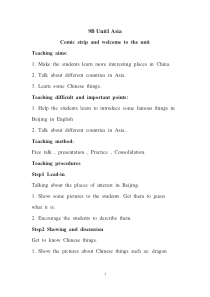 DOC
DOC
【文档说明】《Unit 1 Asia Welcome to the unit》教案2-九年级下册英语【牛津译林版】.docx,共(6)页,25.020 KB,由小喜鸽上传
转载请保留链接:https://www.ichengzhen.cn/view-102775.html
以下为本文档部分文字说明:
19BUnit1AsiaComicstripandwelcometotheunitTeachingaims:1.MakethestudentslearnmoreinterestingplacesinChina.2.TalkaboutdifferentcountriesinAsia.
3.LearnsomeChinesethings.Teachingdifficultandimportantpoints:1.HelpthestudentslearntointroducesomefamousthingsinBeijinginEngl
ish2.TalkaboutdifferentcountriesinAsia..Teachingmethod:Freetalk,presentation,Practice,Consolidation.TeachingproceduresStep1Lead-inTalkingaboutt
heplacesofinterestinBeijing.1.Showsomepicturestothestudents.Getthemtoguesswhatitis.2.Encouragethestudentstodescribethem.Step2Showing
anddiscussionGettoknowChinesethings.1.ShowthepicturesaboutChinesethingssuchas:dragon2dance,Chineseopera,chop
sticks,Chineseknot,ChinesepapercutandChinesekungfu.2.Encouragethestudentstotalkaboutthepictures.3.Encouragethestud
entstosaymoreaboutChinesethings.4.GetthestudentstotalkaboutsomefamousChinesethings.Step3:Learnthe“wecometotheunit”1.Explaintheco
ntextofPartA.MillieisshowingamagazinetotheBritishexchangestudents.ItcontainspicturesofthingsinChina.Askstudentstolabelthepictur
esinPartA,usingthewordsfromthebox..Ifstudentsareunsureofanywords,encouragethemtouseadictionaryorguessthemeaning.Whenstudentsh
avefinishedthesetasks,asksomeofthemtoreadoutthewords.Listenformistakesandmispronunciations.2.showthepictures
ofTian’anmen,thePalaceMuseumandtheGreatWallandsoon.Chooseastudenttoreadoutthenames.3.AnswerthefollowingQs:WheredoesMilliesuggestvi
sitingfirst?WhatspecialthingscanweseeifweareinBeijing?4.Getthestudentstoreadandpracticethedialogueand3th
enactthedialogueout.Step4:Presentation:1.TalkaboutChinesecultureandaskstudentstothinkofmorethingsthatChinais
famousfororthatforeignersrecognizeasbeingspecialtoChina.2.PresentthepictureoftheGreatWallandaskwhenEddieandHoboarevisi
tingtheGreatWall?Step5:ListenandreadTellthestudentsthatEddieandHoboarevisitingtheGreatWall.a.Getthestudentstoli
stenandfindoutwhathappened.1)WouldEddieliketogotravelling?2)WhereareEddieandHobo?3)WhatdoesEddiethinkofthetrip?4)WillEddiekeepmoving?b.Getthestudent
storeadandpracticethedialogueandthenactthedialogueout.Step6Languagepoints1.Wow,theGreatWallisamazing,isn’tit?哇!长城真壮观啊,不是吗?本句是反意
疑问句。这种疑问句有两部分组成,前一部分是陈述句,后一部分是附加的一个简短4问句,中间用逗号隔开。附加问句一般由“be动词/助动词/情态动词+代词”构成。(1)它有两种形式:a、前肯定,后否定e.g.Thisisyourbike,isn’tit?Helikescats,doesn’the
?b.前否定,后肯定。e.g.Thisisn’tyourbook,isit?(2).其答语在“前肯后否”的句子中,答语和一般疑问句答语一样。E.g:Heisyourteacher,isn’the?Yes,heis.\No,heisn’t.是的,他是。\不,他不是。•在“前否后肯”的
句子中,yes翻译成“不”,no翻译成“是”。•E.g:Hecan’tswim,canhe?•Yes,hecan.不,他会。•No,hecan’t.是的,他不会。2.We'dbetterkeepmoving.我们最好坚持走。
•hadbetter(not)dosth最好(不)做某事•hadbetter后接动词的原形•e.g.我最好在妈妈到家前完成家庭作业。5•I'dbetter________(finish)myhomeworkbeforemomgetshome.•keepdoingsth.坚持做某事,一直
做某事•e.g.Hekept_________(talk)untilthemeetingwasover.他一直在说,直到会议结束。Step7PresentationGettoknowthecountriesinAsia.1.Say“whatcountryiseasttoCh
ina”.Showsomepicturesaboutthecountry.(Japan)2.Say“whatcountryisnortheasttoChina”.Sampleconversation:S1:Howd
oyoulearnabouttheworld?Showsomepicturesaboutthecountry.(Korea)3.Say“whatcountryisnorthtoChina”.Showsomepicturesab
outthecountry.(Mongolia)4.Say“whatcountryissouthwesttoChina”.Showsomepicturesaboutthecountry.(India)Encouragethestudentstosaysomethingaboutth
esecountries.Step8ConsolidationWriteashortpassagetodescribeoneofthefamousplacesinChinaandchooseapieceofwritin
gtoreadinclass.Step9:Homework61Recitethecomicstrip2.LearnmoreaboutthingsinChina.3.LearnmoreaboutthenamesoftheplacesofinterestinChina.板书设计Un
it1AsiaPeriod1Comicstripandwelcometotheunit1.Words:tiring,step,Chineseknot,Chineseopera,dragondance,chopsticks2.Phrases:takearest,onone’swa
yback,wakemeup,3.Sentences:Thereisstillalongwaytogo.We’dbetterkeepmoving.4.反义疑问句的应用。教后反思1.这节课教师充分通过各种手段调动了学生的积极性,学生参与面广,师生互动
很多。不光教会了学生课本上的知识,也教会了他们一些课本上学不到的东西,培养了他们的观察力。2.采用提问,表演,复述等多种手段,让学生无枯燥乏味之感。轻松学习。3.做到让学生玩中学,学中玩。轻松完成学习任务。符合任务型的教学原则。4.因材施教,及一带一形式不让任何一个学生无事可做。并发挥群众力
量,让学生们自己走上讲台当老师。体现学生主体原则。5.当堂课应要求练习口语,小错误不予追究,可以在课后以书面形式改正。6.小组活动仍需改进,要有序的组织好。否则难以达到最佳效果。
 辽公网安备 21102102000191号
辽公网安备 21102102000191号
 营业执照
营业执照